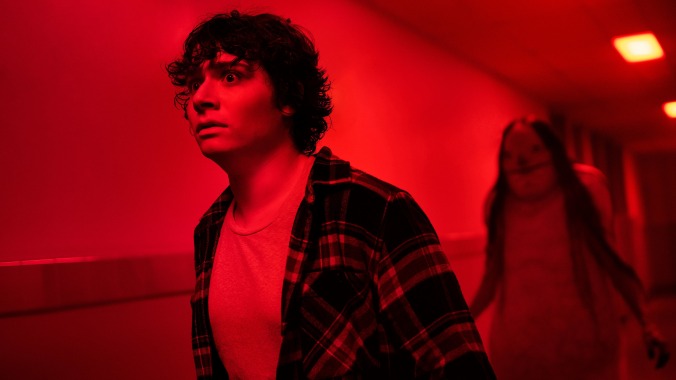Scary Stories To Tell In The Dark could scare kids as much as the books scared their parents


A plump, severed toe floats to the surface of a meat stew, ready to be unwittingly gobbled. A decapitated head rolls down a chimney, then springs to maniacal, vaudevillian life, shouting and singing. A spider bite on a cheek keeps growing and growing and growing, until… well, arachnophobes beware. Like scouts huddled around a campfire, each trying to send a bigger chill down the others’ spines, Scary Stories To Tell In The Dark keeps coming up with new gruesome attractions, piling one on top of the next. Yet as gross and spooky and, yes, occasionally frightening as these terror tactics get, they never quite cross over into the deep end of truly grown-up horror. That’s intentional, and a key to the film’s fun: It gets away with everything it can on a PG-13 leash, smuggling some real scares to the under-18 crowd.
You usually have to go back to the ’80s to find Hollywood movies that dare creep up to the line separating thrillers for adults from the all-ages kind. Perhaps not coincidentally, that was the decade when the first of Alvin Schwartz’s Scary Stories collections was published. The books, a staple of elementary school libraries in the ’80s and ’90s, plainly retold various folklore, urban legends, and wives’ tales, with a focus on how to most effectively deliver them to a rapt crowd of fellow campers or sleepover peers. (To that end, many of the tales ended with an “AHHHHHHHHH.”) What really branded the stories onto the collective millennial imagination was the gloomy, goopy artwork by Stephen Gammell: unforgettable images of ghouls and phantoms, their grinning skulls coated in a dripping, viscous, midnight-black substance. You felt like you were getting away with something reading those books, and maybe you were; there was a real push to ban them from schools.
Directed by André Øvredal, from a script co-written by premier monster lover (and newly minted Oscar winner) Guillermo del Toro, Scary Stories To Tell In The Dark makes little attempt to replicate Gammell’s monochromatically macabre imagery. Nor does it adhere to the anthology format of its source material. The approach is closer, conceptually speaking, to the Goosebumps movie, with Øvredal and del Toro cherry-picking some of the most memorable frights from Schwartz’s library. Here, his beasties come from the diary of a town legend, a supposed child-murderer from the late 19th century whose rich family kept her locked up in their sprawling estate. Fleeing some bullies on Halloween night, teenage horror buff Stella (Zoe Margaret Colletti, an agreeably brainy scream queen) and her dorky friends stumble into the darkened, abandoned mansion, where they uncover the cursed book. Much to their horror, they soon find themselves terrorized by an undead storyteller with a grudge, the empty pages filling up with premonitions of their untimely ends and their sleepy 1960s Pennsylvania town overrun with monsters.
Whenever Scary Stories is prioritizing the scary stories, it becomes a lively bit of supernatural-slasher hokum. Øvredal, who made Trollhunter and the unnerving Autopsy Of Jane Doe, savors the suspense during set pieces that bring Schwartz’s ghoulish, recounted yarns to three-dimensional life. One, involving a shambling, single-minded corpse hunting for a missing body part, slows the action down to a heart-stopping crawl, delaying the big scare for minutes on end. Another compounds the nightmarish inevitability—a cornerstone of Schwartz’s work—by turning one of the kids’ bad dreams into a self-fulfilling prophecy, as he gets cornered in a hospital, surrounded on all sides by pasty, obese specters shuffling down its red-tinted hallways. Øvredal, in general, directs with a fluid flair, gliding his camera around the quaint small-town setting like an evil spirit and efficiently introducing his characters during a stylish opening montage set to Donovan’s “Season Of The Witch.”
The plot, however, is mostly boilerplate. It feels calibrated—vaguely but cynically—to capitalize on the popularity of Netflix’s wistful Amblin imitation Stranger Things. (Yes, we’re looking at another Spielbergian throwback, albeit one more indebted to Poltergeist than E.T.) Del Toro, working with screenwriters Dan and Kevin Hageman, festoons the funhouse fun with explicit commentary on the dangers of spreading rumors and tall tales, which almost feels like an indictment of the urban legends Schwartz helped immortalize. Is it really a veiled attack on a culture of dangerous misinformation? Lest that sound like a stretch for an adaptation of a kid-lit campfire-tale collection, know that Scary Stories fills the background of many scenes with the specters of Nixon, Vietnam, and the 1968 election, while also making room for a subplot involving the small-town racism faced by Stella’s mysterious, nomadic, new-in-town boyfriend, Ramón (Michael Garza). It’s all a little muddled.
None of this, again, actually has much in common with the Scary Stories books, which pushed a starker analog dread: To a young reader, there was something disquietingly convincing about their direct prose and abrupt endings—they gave superstition the chill of oral history. Here, the CGI monstrosities, like a crab-walking abomination capable of falling into pieces and then reassembling, are often wondrously creepy creations. But none are half as memorable as Gammell’s drawings, so haunting in their still-frame vividness that they were removed from later re-printings of the books. Still, in its blurring of demographic lines (who is this movie for, really?), Scary Stories does manage to put its own spin on the parent-incensing spirit of the original. It’s the rare horror movie that feels both “suitable” for adolescents and determined to really scare the living shit out of them—to give them the kind of jolts of fear most “movies for children” over-protectively deny them. Plenty of kids may end up feeling like they got away with something here, too.